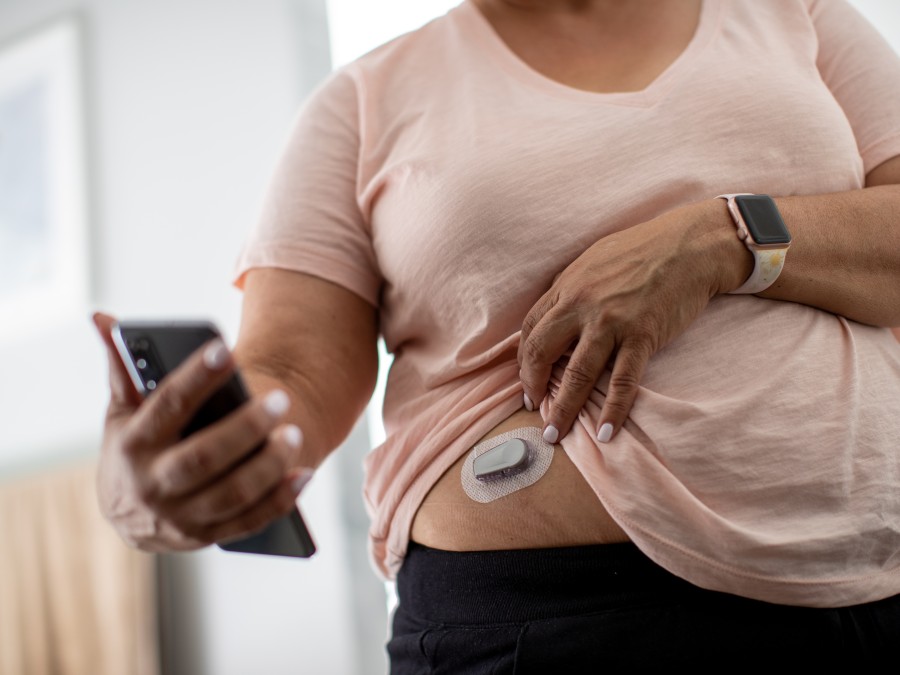What is an artificial pancreas? An in-depth guide

What is an artificial pancreas? An in-depth guide
Diabetes technology is rapidly evolving. One such technology is the artificial pancreas — also known as a closed-loop system, or hybrid closed-loop system.
When used correctly, an artificial pancreas can manage blood glucose better, reduce the risk of hypoglycaemia and offer a better quality of life if you’re living with type 1 diabetes. But just what is an artificial pancreas?
Our guide answers this question. Whether you’ve recently been diagnosed with diabetes or you want to find out more about this new type of insulin management, you’ve come to the right place.
In this guide, we take a closer look at hybrid closed-loop systems which are currently available, the technology behind the artificial pancreas, and promising complete closed-loop systems in development.
Find out more about this innovative diabetes technology below.
What is an artificial pancreas?
An artificial pancreas, also known as a hybrid closed-loop system, is a way to manage diabetes.
Artificial pancreas systems use innovative man-made technology to mimic the way the human pancreas naturally regulates blood glucose — automatically adjusting insulin delivery to help manage blood glucose levels.
The term ‘artificial pancreas’ covers any system that automatically calculates the dose of insulin your body needs based on readings from a sensor, before releasing the hormone into the body.
What is the pancreas?
To understand an artificial pancreas and how it works, it helps to know a bit more about the pancreas.
The pancreas is an organ in the upper abdomen that plays a crucial role in digestion and glucose regulation in the blood. It secretes hormones including insulin and glucagon that stabilise blood glucose levels — preventing them from getting too high or too low.
When your blood glucose rises after eating, the beta cells in the pancreas release insulin, which lets your body use and store glucose, reducing the levels in your blood. When your blood glucose levels drop if you exercise or haven't eaten for a while, the pancreas releases glucagon. Glucagon makes the body release stored glucose to increase blood levels and fuel your body’s function.
When you live with type 1 diabetes, your body can’t produce enough of the hormone insulin. You need to inject insulin to stabilise your glucose levels and ensure your cells get the glucose energy they need to function and live. If you have type 1, you need to adjust your insulin dose to keep your glucose in the target range and prevent diabetes complications — including eye and kidney damage, heart disease, stroke and amputations.
An artificial pancreas aims to improve blood glucose management by mimicking how the pancreas works, with some input from the user. This can reduce the time and effort involved in managing your diabetes.
Hybrid closed-loop technology
Hybrid closed-loops are a type of artificial pancreas; they are the most advanced insulin delivery systems currently available.
Hybrid closed-loop technology uses a sophisticated computer programme to take glucose readings from a continuous glucose monitor (CGM), calculate the insulin needed and deliver that insulin through a pump.
The system is designed to measure and automatically adjust the basal (background) rate of insulin delivery if your blood glucose goes too low or too high. They're called 'hybrid' systems or technology because, as a user, you will still have to count the carbohydrates in your food and programme boluses (rapid-acting doses) at mealtimes.
Hybrid closed-loop systems are made up of three parts — an insulin pump, a continuous glucose monitor and an algorithm:
- A continuous subcutaneous insulin infusion pump (CSII) is a digital device that delivers a steady stream of insulin under the skin throughout the day and night.
- A continuous glucose monitor (CGM) is a device implanted under your skin that automatically checks your glucose levels every few minutes, 24 hours a day. It uses a wireless transmitter to send readings to a device.
- The control algorithm is intelligent technology either embedded in the pump or on a control unit like a smartphone. It communicates with the CGM and the pump, allowing them to work together to manage your diabetes.
The algorithm responds to your glucose readings in real-time, calculating the dose of insulin you need. It then communicates with your pump, changing the insulin delivery rate to keep your blood glucose levels stable. The system works around the clock — even when you’re asleep and can’t check your levels — to manage your diabetes, and the cycle is repeated at regular intervals every 5–12 minutes, depending on the system.
Although you won’t need to finger-prick as frequently with an artificial pancreas, you will still need to manage your diabetes yourself. This will include administering boluses for carbohydrate-containing meals and snacks in advance, setting bolus timings, programming the appropriate alarm settings (these systems have all the alarm features associated with CGM), and managing the treatment of hypoglycaemia or hyperglycaemia.
The pros and cons of hybrid closed-loop technology
Hybrid closed-loop technology is still relatively new — it has been a century since the discovery of insulin — and you might want to know more about the advantages and disadvantages of using an artificial pancreas before you consider using it.
Advantages of hybrid closed-loop systems
Research shows that hybrid closed-loop systems have acceptable safety and efficacy profiles — improving glucose management, reducing the risk of hypoglycaemia (also known as ‘hypos’), and improving the quality of life for people living with type 1 diabetes.
The benefits include:
- Better glucose management: artificial pancreas systems increase your time within the target glucose range, reducing your time in states of hypoglycaemia or hyperglycaemia. Improved glucose management is linked to reduced risk of developing the long-term complications of diabetes.
- Reduced risk of dangerous hypoglycaemia: in both children and adults living with type 1 diabetes.
- Reduced work and stress: managing diabetes takes time, work and concentration, which can be a burden for users and carers. A hybrid closed-loop system reduces diabetes demands and offers users some time off.
- Lifestyle flexibility: an artificial pancreas can improve quality of life — helping you exercise, and live more flexibly without worrying about high or low glucose levels.
- Improved wellbeing: using a hybrid closed-loop system can offer increased reassurance, reduced anxiety and better sleep. You may feel more confident in your diabetes management.
Considerations when using a hybrid closed-loop systems
Hybrid closed-loop systems take work and do have some disadvantages. You will still need to count carbohydrates in your food and
programme extra insulin doses at mealtimes. Exercise, alcohol, high carbohydrate and high-fat meals all remain as things to manage even with hybrid closed-loop systems, so management strategies need to be tailored to your individual needs. Training and support from healthcare professionals are also needed and will be supplied if you take on this therapy.
Being aware of the main advantages and disadvantages of using an artificial pancreas can help you to decide when you want to try this relatively new technology. You can also speak to your GP or a healthcare professional to see what they would suggest for you too.
What is the future of closed-loop technology?
It’s an exciting time in diabetes treatment and access to closed-loop technology may prove to be life-changing for many people living with diabetes.
A stable synthetic form of glucagon analogue (a type of medicine used in the treatment and management of diabetes) could make pumps that infuse insulin and glucagon possible — adding extra protection from hypoglycaemia.
On top of this, new faster-acting insulins could improve hybrid closed-loop systems, responding rapidly to glucose increases when eating, without the user needing to add a bolus.
More research and development in this area is needed before we are able to make a fully closed-loop system a reality. A complete closed-loop system would mean that you don't need to add bolus doses when eating a carbohydrate meal or snack.
Can you get an artificial pancreas in the UK?
Several artificial pancreas systems are available commercially in the UK, with many more in development.
The NHS is collecting data on hybrid closed-loop systems and is currently undertaking a trial to support the wider roll-out of artificial pancreas technology across England for people with type 1 diabetes.
Source
- Hartnell, S., Fuchs, J., Boughton, C.K. and Hovorka, R. (2021). Closed-loop technology: a practical guide. Pract Diab, 38: 33-39. https://doi.org/10.1002/pdi.2350 https://wchh.onlinelibrary.wiley.com/doi/full/10.1002/pdi.2350
- Messer LH. Why Expectations Will Determine the Future of Artificial Pancreas. Diabetes Technol Ther. 2018 Jun; 20(S2): S265-S268. DOI: 10.1089/dia.2018.0116. PMID: 29916739
- NHS to pilot artificial pancreas tech for people with type 1 diabetes, JDRF. Last accessed 04/01/2022: https://jdrf.org.uk/news/nhs-to-pilot-artificial-pancreas-tech-for-people-with-type-1-diabetes/
- Leelarathna, L., Choudhary, P., Wilmot, E., Lumb, A., Street, T., Kar, P., & Ng, Sze. (2020). Hybrid Closed‐loop therapy: Where are we in 2021?. Diabetes, Obesity and Metabolism. 23. 10.1111/dom.14273. https://www.researchgate.net/publication/347301993_Hybrid_Closed-loop_therapy_Where_are_we_in_2021
- Bekiari E., Kitsios K., Thabit H., Tauschmann M., Athanasiadou E., Karagiannis T. et al. Artificial pancreas treatment for outpatients with type 1 diabetes: systematic review and meta-analysis BMJ 2018; 361: k1310 doi:10.1136/bmj.k1310 https://core.ac.uk/download/pdf/157857946.pdf
- Röder, P., Wu, B., Liu, Y., Han, W. (2016) Pancreatic regulation of glucose homeostasis. Experimental & Molecular Medicine, 48, e219. DOI:10.1038/emm.2016.6.





